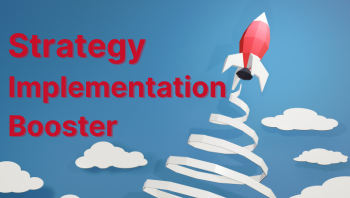From PowerPoint to practice: How strategies finally become effective
“Our strategy is great – but no one is implementing it.”
Welcome to PowerPoint hell.
This is where 95% of all corporate strategies live a lonely life between slides 23 and 47 before ending up in a desk drawer.
McKinsey studies confirm that 45% of 800 executives surveyed admitted that their strategy processes do not track the implementation of strategic initiatives. Gartner adds that 67% of key functions are not aligned with the corporate strategy.
The problem is not the strategy. The problem is executives who believe that strategy development and strategy implementation are two different things. Spoiler alert: they are not.
Strategy implementation is not a downstream project. It is integrated change management. And without it, your brilliant strategy is just expensive paper.
The classic implementation killers I see every day:
The proclamation CEO: Presents the new strategy in a 90-minute meeting and wonders why everyone is back to doing the same old thing three months later. As if people were software that could be updated.
The detail lover: Has a plan for everything, but forgets about the people. 247 measures in an Excel spreadsheet – but no one knows why they should do any of it.
The impatient one: Expects initial results after four weeks and complete transformation after eight weeks. But cultural change takes years, not months.
How does effective strategy implementation really work?
1. Involvement from the outset: Strategy work is a “system performance.”
“Not invented here” is the death of any strategy. People only implement what they have helped to develop. Or at least understand.
Only strategy work that specifically considers and shapes the content of the strategy, the related corporate structure, and the supporting corporate culture has a chance of being successfully implemented.
2. Brutal clarity instead of nice words
“We will become more customer-oriented” means something different to everyone. “Every customer call will be answered within 24 hours” is clear.
Most strategies fail because of vague wording. Try this test: After reading your strategy, can an intern say specifically what they should do differently? No? Then it's too vague.
3. Translation into everyday life
Strategies don't live in quarterly reports, but in Monday meetings, customer appointments, and coffee break conversations.
Specifically: If your strategy includes “innovation,” what does that look like in the weekly team meeting? What questions do you ask differently? What decisions do you make differently?
4. Quick wins as momentum builders
People need quick wins to believe in longer-term change.
Real-life example: A mechanical engineering company wanted to become more agile. Instead of starting with the entire organizational structure, they began with budget approval: Team leaders could make decisions immediately for amounts under $5,000.
The result: Within four weeks, projects were 60% faster. Everyone saw that it really worked.
5. Managers as translators, not rulers
The role of managers is changing completely: from instructing to explaining. From controlling to enabling.
In concrete terms, this means
- Explaining in every meeting how the current topic fits into the strategy
- Making the strategic principles behind every decision transparent
- Treating mistakes as learning opportunities if they were made in line with the strategy
6. Nudges instead of coercion
People don't change their behavior through rules, but through new habits.
Practical example: A consulting firm wanted to become more “collaborative.” Instead of conducting lengthy training sessions, they redesigned all their meeting rooms: standing tables instead of conference tables, whiteboards on every wall, no fixed seating.
The result: meetings automatically became more interactive and shorter.
The drama of the typical strategy process:
Months 1-3: Strategy development (expensive, time-consuming, perfect)
Month 4: Communication (PowerPoint battle)
Months 5-12: Everyone does what they want
Month 13: “Our strategy isn't working.”
How to do it right:
Month 1: Develop strategy hypotheses and formulate strategic goals (with the people who are supposed to implement them)
Month 2: Initial tests and quick wins
Month 3: Adjustments based on learnings
Months 4-12: Continuous adjustment and reinforcement
My recipe for success in strategy implementation:
The 3-R rule – and everything based on strong consensus:
- Relevance: Why is this important for ME?
- Realism: Can I achieve this with the resources I have?
- Resonance: Does this fit with what I believe is right?
- Strong consensus: For all strategic decisions, at least 80% of those involved in the strategy should agree 80% personally. “I can live with that” is out!
If one of the three Rs is missing, your strategy becomes lip service.
An anti-example to conclude:
Manufacturing company, 800 employees. New strategy: “Sustainability First.” Implementation: Everyone receives a sustainability handbook and is expected to reduce CO2 emissions. At the same time, bonuses continue to be awarded only for productivity and cost reduction.
Result after one year: The handbook lies around unread, everyone continues as before.
The solution would have been: Incorporate sustainability into the target systems, celebrate quick wins in energy savings, reward teams for innovative environmental solutions.
Your task for this week:
Take a look at your current strategy and ask yourself honestly:
- Who besides management can explain it in their own words?
- What specific behavioral changes do you expect?
- What have you done in the last four weeks to promote implementation?
If you stumble over the last question, you know what you need to work on.
The uncomfortable truth: Strategy implementation is 20% planning and 80% leadership. Leadership is the constant translation between vision and everyday life.
Those who understand this will see their strategies come to life. Those who ignore this will collect nice PowerPoint presentations.
Sources: McKinsey Strategic Execution Survey (2020), Gartner Strategic Alignment Research (2024), Harvard Business Review “Strategy Execution Unravels” (2015)
Your experience: Where have you seen a strategy really come to life? And where has a good idea failed because of poor implementation?
That was the last part of my short series on strategy. Thank you for reading and commenting. Strategy work thrives on exchange – so I look forward to hearing about your experiences and questions.
S T O P... Haven't we forgotten something? Next week, we'll talk about something that some companies still don't take seriously. Stay tuned!


About me

All Rights Reserved
Get in touch
-
+49-(0)941 600 93 003
-
This email address is being protected from spambots. You need JavaScript enabled to view it. -
Thomas_Huber
ToChange Gmbh
-
Thomas Huber
-
Traubengasse 6
-
D-93059 Regensburg

